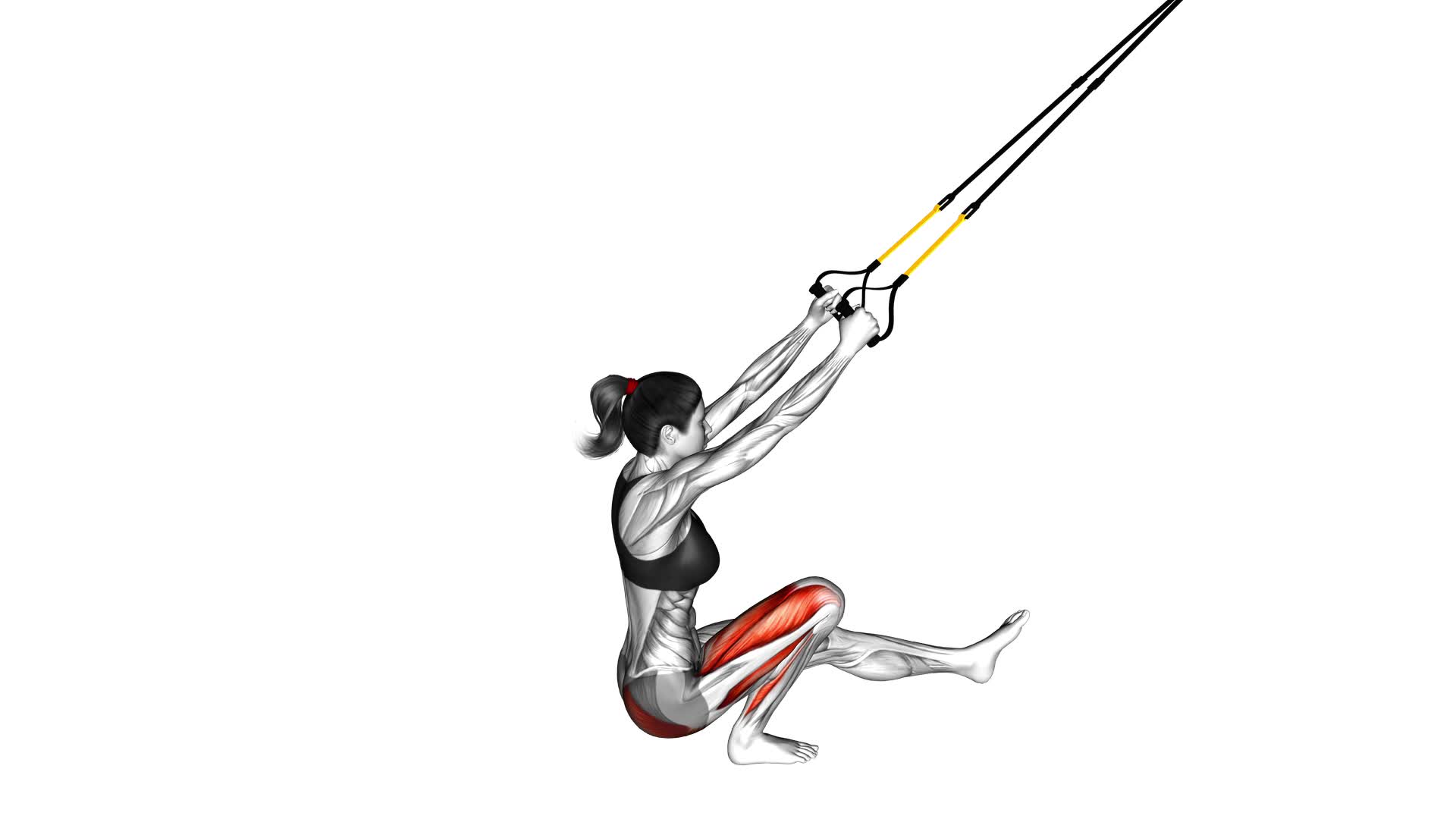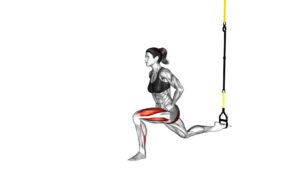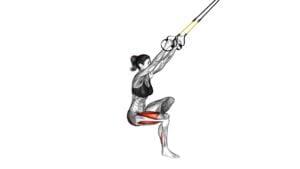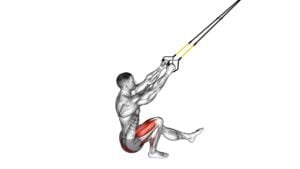Suspender Single Leg Squat (female) – Video Exercise Guide & Tips

Are you looking to strengthen your legs and improve your balance? Then the Suspender Single Leg Squat is the perfect exercise for you.
Watch This Exercise Video
In this video exercise guide, we'll show you the proper form and technique to maximize the benefits of this exercise.
We'll also discuss common mistakes to avoid and provide variations and progressions to challenge yourself.
Get ready to elevate your leg workout with this effective and challenging exercise.
Key Takeaways
- The Suspender Single Leg Squat improves balance and strengthens the lower body, making it beneficial for athletes or individuals who require good balance.
- The exercise targets the quadriceps, hamstrings, and glutes, helping to enhance overall balance and strength in these muscles.
- Proper form and technique are crucial, with a focus on engaging the core and avoiding common mistakes such as leaning too far forward or allowing the knees to collapse inward.
- Variations and progressions can be incorporated to challenge the muscles further, such as using weights or a stability ball, changing leg position or squat angle, or elevating the front foot on a step or platform.
Benefits of the Suspender Single Leg Squat
The benefits of the Suspender Single Leg Squat include improving balance and strengthening the lower body. This exercise challenges your body to stabilize itself, enhancing overall balance. It is particularly beneficial for athletes or individuals involved in activities that require good balance, such as dancing or martial arts.
Additionally, the Suspender Single Leg Squat targets the muscles in your legs, including your quadriceps, hamstrings, and glutes. As you lower yourself into the squat position, these muscles are activated and engaged, leading to increased strength and muscle tone. This exercise also works your core muscles, as they are required for stability and proper form throughout the movement.
Equipment Needed for the Exercise
To perform the Suspender Single Leg Squat, you'll need a pair of suspenders. These suspenders are essential as they provide the necessary support and stability for your body during the exercise. It's important to choose suspenders that are sturdy and can hold your weight without slipping or breaking. Look for suspenders made of durable materials such as nylon or polyester.
If you find it challenging to perform the exercise with suspenders, there are some modifications you can make. One option is to use resistance bands instead of suspenders. These bands can be attached to a stable anchor point and then looped around your body to provide the necessary support. Another modification is to use a fitness ball or a wall for additional stability. By leaning against the ball or the wall, you can reduce the amount of balance required and focus more on the squatting movement.
If you don't have access to suspenders or prefer not to use them, there are alternative exercises that target similar muscle groups. Some examples include the Bulgarian split squat, the pistol squat, or the step-up exercise. These exercises can be performed with or without weights, depending on your fitness level and goals.
Proper Form and Technique
To perform the Suspender Single Leg Squat with proper form and technique, it's important to understand the significance of core stability. Engaging your core muscles will help you maintain balance and control throughout the exercise.
Additionally, be aware of common form mistakes such as leaning too far forward or allowing your knee to collapse inward. By focusing on core stability and avoiding these common errors, you can maximize the effectiveness and safety of the exercise.
Core Stability Importance
To properly execute the Suspender Single Leg Squat (female), it's essential that you consistently engage your core for stability and maintain proper form and technique. Core strength is crucial for overall stability and balance during exercises.
Here are the benefits of stability training and the importance of core strength:
- Improved posture: Engaging your core muscles helps align your spine and maintain a good posture, reducing the risk of injuries and promoting a healthy back.
- Increased strength: A strong core not only helps you perform exercises more efficiently but also enhances your overall strength and power.
- Injury prevention: A stable core acts as a strong foundation, reducing the risk of injuries in other parts of the body.
By focusing on core stability, you can optimize your performance and protect yourself from potential injuries.
Now let's dive into the common form mistakes to avoid during the Suspender Single Leg Squat (female).
Common Form Mistakes
What are some common form mistakes to avoid when performing the Suspender Single Leg Squat (female)?
Proper form and technique are crucial for maximizing the benefits of this exercise while minimizing the risk of injury. One common mistake is failing to engage your core throughout the movement. Remember to brace your core by pulling your belly button in towards your spine. This will help stabilize your body and maintain proper alignment.
Another mistake is neglecting balance techniques. It's important to distribute your weight evenly between your supporting leg and the suspended leg. Keep your gaze fixed on a focal point to help with balance.
Additionally, avoid leaning forward or rounding your back, as this can place unnecessary strain on your lower back. Focus on maintaining a tall, upright posture throughout the exercise.
Common Mistakes to Avoid
Avoiding these common mistakes will help you perform the Suspender Single Leg Squat correctly and effectively. Here are some key mistakes to avoid when performing this exercise:
- Using improper form: It's important to maintain proper form throughout the exercise to avoid injury. Keep your back straight, chest up, and core engaged. Avoid rounding your back or leaning too far forward.
- Neglecting the modification options: If you find the Suspender Single Leg Squat too challenging, don't push yourself too hard. Instead, try modifying the exercise by using a lower suspension point or by using a resistance band for assistance. This will help you build strength gradually and prevent injury.
- Rushing through the movement: Take your time and focus on the quality of each repetition. Avoid rushing through the exercise, as this can lead to poor form and potential injuries. Control the movement and engage the targeted muscles throughout the entire range of motion.
Variations and Progressions
To progress the Suspender Single Leg Squat, you can incorporate variations and modifications to challenge your muscles further and enhance your strength and stability. Advanced modifications of this exercise can be done by adding weights or using a stability ball. By holding a dumbbell in each hand or placing a weighted plate on your chest, you increase the resistance and make the exercise more challenging. This will engage your muscles even more and help you build strength and stability in your legs and core.
Another way to progress the Suspender Single Leg Squat is by using muscle targeting techniques. You can focus on different muscle groups by changing the position of your legs or the angle of your squat. For example, you can perform a wide-legged squat to target your inner thighs or a narrow-legged squat to target your outer thighs. You can also try elevating your front foot on a step or platform to increase the intensity and target your glutes and hamstrings.
Tips for Getting the Most Out of Your Workout
To get the most out of your workout, it's important to focus on maximizing effectiveness and avoiding common mistakes.
By ensuring proper form and technique, you can target the intended muscles and prevent injuries.
Additionally, incorporating variety and progression into your routine will challenge your body and help you achieve continued progress.
Maximizing Workout Effectiveness
Are you maximizing the effectiveness of your workout? To get the most out of your fitness routine, it's important to focus on workout intensity and muscle activation. Here are some tips to help you maximize your workout effectiveness:
- Increase the intensity: Push yourself to work harder by increasing the weight or resistance, increasing the duration of your workouts, or incorporating high-intensity interval training (HIIT) into your routine.
- Activate more muscles: Engage multiple muscle groups during your workouts by performing compound exercises like squats, deadlifts, and push-ups. These exercises not only target specific muscles but also recruit surrounding muscles, leading to a more efficient and effective workout.
- Vary your routine: Avoid plateauing by constantly challenging your body with new exercises, different workout formats, and varying levels of intensity. This will keep your muscles guessing and prevent boredom.
Avoiding Common Workout Mistakes
To get the most out of your workout and avoid common mistakes, make sure you're following proper form and technique. Avoiding injury is crucial, so always prioritize safety during your workouts.
One important aspect of preventing injuries is to perform a proper warm-up before starting your exercise routine. A proper warm-up helps to increase blood flow to your muscles, preparing them for the upcoming workout and reducing the risk of strains or sprains. Incorporate dynamic stretches and light cardio exercises to warm up your body and get your muscles ready for action.
Additionally, focus on maintaining proper form during exercises to prevent unnecessary strain on your joints and muscles.
Frequently Asked Questions
How Many Repetitions Should I Do for the Suspender Single Leg Squat?
For the suspender single leg squat, the number of repetitions you should do depends on your fitness level and goals. It's generally recommended to start with 8-12 repetitions per leg and gradually increase as you get stronger.
Single leg exercises like this one are great for targeting individual muscles and improving balance and stability. They also help to correct muscle imbalances and prevent injuries.
Incorporating them into your workout routine can bring many benefits to your overall fitness.
Can I Do the Suspender Single Leg Squat if I Have Knee Pain?
Yes, you can do the suspender single leg squat even if you have knee pain. However, it's important to consult with a healthcare professional or a certified trainer before attempting this exercise.
They can provide alternatives for knee-friendly lower body exercises that can help you strengthen your legs without aggravating your knee pain.
Additionally, focusing on proper form and technique during squats is crucial in preventing knee pain and ensuring a safe and effective workout.
Is It Necessary to Use Suspenders for the Suspender Single Leg Squat?
No, it isn't necessary to use suspenders for the suspender single leg squat. There are alternatives you can try, such as using a resistance band or holding onto a stable object for support.
However, using suspenders can provide additional benefits. They can help improve stability and balance during the exercise, making it easier to maintain proper form.
Ultimately, whether or not to use suspenders depends on your personal preference and comfort level.
How Often Should I Incorporate the Suspender Single Leg Squat Into My Workout Routine?
To get the most out of your workout routine, it's important to incorporate the suspender single leg squat regularly. This exercise offers numerous benefits, such as improving balance, strengthening your legs, and engaging your core muscles.
You can vary the intensity by adjusting the height of the suspenders or using different variations of single leg squats. Aim to include this exercise two to three times a week to see optimal results and gradually increase the difficulty as you progress.
Can the Suspender Single Leg Squat Help Improve My Balance and Stability?
The suspender single leg squat is a great exercise for improving balance and stability. It specifically targets the muscles in your legs and core that are responsible for maintaining balance. Compared to other exercises, it's highly effective in developing these skills.
If you have limited balance or stability, there are modifications and variations that can be done to make it more accessible.
Conclusion
In conclusion, the suspender single leg squat is a highly effective exercise for strengthening the lower body and improving balance. With the proper form and technique, this exercise can target the quads, glutes, and hamstrings while also challenging the core.
By avoiding common mistakes and incorporating variations and progressions, you can continue to challenge your muscles and see progress over time. Remember to listen to your body and use proper equipment to ensure a safe and effective workout.

Author
Years ago, the spark of my life’s passion ignited in my mind the moment I stepped into the local gym for the first time. The inaugural bead of perspiration, the initial endeavor, the very first surge of endorphins, and a sense of pride that washed over me post-workout marked the beginning of my deep-seated interest in strength sports, fitness, and sports nutrition. This very curiosity blossomed rapidly into a profound fascination, propelling me to earn a Master’s degree in Physical Education from the Academy of Physical Education in Krakow, followed by a Sports Manager diploma from the Jagiellonian University. My journey of growth led me to gain more specialized qualifications, such as being a certified personal trainer with a focus on sports dietetics, a lifeguard, and an instructor for wellness and corrective gymnastics. Theoretical knowledge paired seamlessly with practical experience, reinforcing my belief that the transformation of individuals under my guidance was also a reflection of my personal growth. This belief holds true even today. Each day, I strive to push the boundaries and explore new realms. These realms gently elevate me to greater heights. The unique combination of passion for my field and the continuous quest for growth fuels my drive to break new ground.



